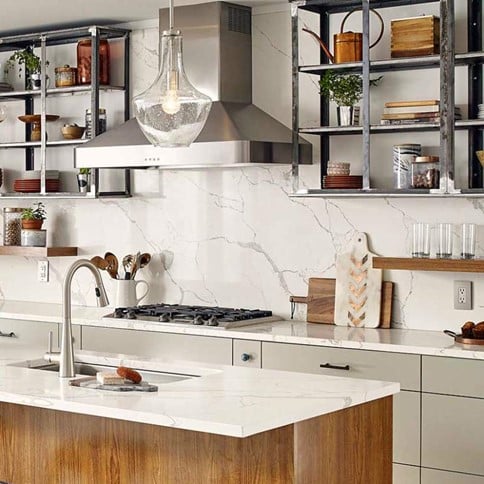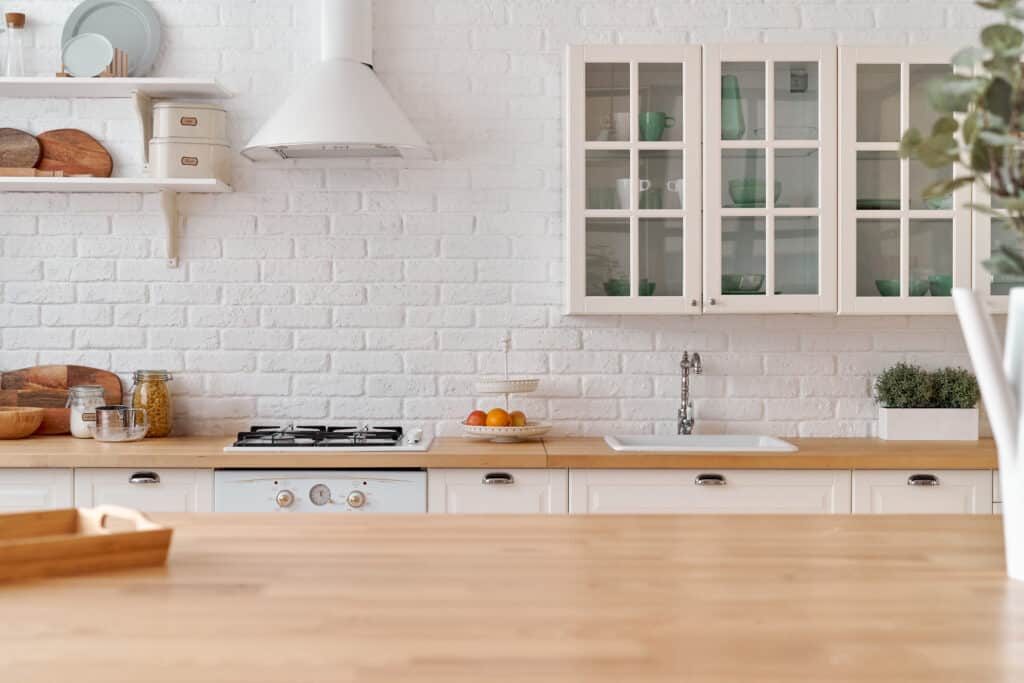Choosing kitchen countertops is one of the most significant decisions you’ll make when remodeling your kitchen. Good Housekeeping argues that countertops are the most important element in a kitchen remodel:
“Not only do you interact with them every day, but they’re one of the first things a person notices when they walk into the space, making them a key focal point.”
Good Housekeeping
Setting the tone for the hub of your home, countertops impact your kitchen’s functionality and style. With that in mind, it’s important to seek advice from a professional to understand everything there is to know about selecting the right countertops for your home.
Factors to consider when choosing a countertop material
We all want to love the look of our new countertops, but there are other essential things to consider to help you make the right choice for your kitchen. Start with cost. You don’t want to fall head over heels for a material that’s out of your price range. Do research about your options, first considering cost and aesthetics to get the look you want within budget. Then, consider durability to determine which material best matches how you use and live in your kitchen.
Finally, decide whether you want to commit to a rigorous maintenance routine or just a quick everyday wipe-down. Being thoughtful about the type of care and maintenance required will help lead you to a countertop surface you’ll be happy with for the long term. Here’s more food for thought:
- Cost. Good Housekeeping notes the price tag for countertops materials and installation runs the gamut, “from high-end imported materials, like Calacatta marble from Italy or Van Gogh granite from Brazil to entry-level laminate.” In addition to material costs, for some countertops, you’ll pay extra for edge treatments such as square or rounded edges, which are typically charged by the foot—elements to keep in mind as you budget for your new surfaces.
- Durability. Know your materials. Natural stone is inherently porous. On the contrary, composite or engineered countertop materials are more durable by design, so they are generally more resistant to scratches, chipping and stains.
- Maintenance and upkeep. The porosity of the countertop material and its finish dictate the level of care required to keep your countertops looking and performing well. “A nonporous material with a polished finish is unlikely to absorb anything, making it stain-resistant. Honed finishes, in which the surface has been ground down to give the countertop a softer, matte feel, require a bit more care, but you might be willing to put up with that for the softer feel and reduction in glare.” (Good Housekeeping)
- Style and design. Kitchen design trends come and go – and countertop materials are a big part of that conversation. In 2023, countertop trends include dramatic, natural stone countertops, continuing up the wall as backsplashes and as a waterfall effect on islands. Quartz and butcherblock are also top designer choices.
Because new countertops are an investment, it’s wise to choose the material that best suits your design style and preferences—not just what’s on-trend. But if you’re considering selling your home soon, a neutral, easy-care option is a safer bet.
Types of countertop materials
What is the best material to use for kitchen countertops? It’s a loaded question—and one we hear often. To help you determine the best choice for your kitchen and lifestyle, here’s a breakdown of countertop materials with some pros and cons of each.
Natural stone (granite, marble, quartzite, soapstone)
Natural stone surfaces are inherently hard, durable and heat-resistant, making them an exceptionally functional kitchen countertop material. But, while stone surfaces are also easy to clean, they require regular maintenance to keep them looking and performing their best.
Pros:
- Unique and luxurious appearance
- Durable and long-lasting
- Heat-resistant
- Add value to the home
Cons:
- Require regular maintenance and sealing
- Can be expensive
- Can crack or chip if not handled properly
- Susceptible to stains and scratches
Engineered stone (quartz)
Quartz is hailed as one of the most durable countertop choices. Made of crushed quartz stone mixed with polymers and resin, quartz is a highly durable surface that resembles natural stone and is available in various colors, striations or patterns. It is chameleon-like, adapting to almost any home style.
Pros:
- Durable and long-lasting
- Non-porous and hygienic
- Easy to maintain and clean
- Wide variety of colors and styles available
Cons:
- Can be expensive
- Not heat-resistant
- Can be prone to discoloration over time
- Requires professional installation
Solid surface
Solid surface countertop materials are a composite of mineral dust combined with acrylic, resins and pigments. Solid surface offers a seamless look, is more affordable than natural stone and can provide similar design appeal, but it also shows everyday wear and tear.
Pros:
- Non-porous and hygienic
- Seamless installation
- Easy to maintain and repair
- Can mimic the look of natural stone
Cons:
- Can be prone to scratches and chips
- Not heat-resistant
- Can discolor over time
- Limited color and style options
Wood (butcher block)
Wood is an increasingly popular countertop choice—it adds warmth and texture to a room and has an organic quality that’s right on-trend. But, because wood countertops are soft, they can easily scratch and potentially crack, especially if the wood is poorly maintained.
Pros:
- Warm, natural appearance
- Easy to clean and maintain
- Can be refinished if damaged
- Sustainable and eco-friendly option
Cons:
- Prone to water damage and stains
- Requires regular oiling and sealing
- Not heat-resistant
- Can be prone to scratches and dents
Aesthetic choices for countertops
After you’ve selected the material for your kitchen countertops, you can make your surfaces your own to reflect your unique design style and functionality. From colors and finishes to edge styles, here are the aesthetic elements to consider for your countertop installation:
- Color/patterns. All countertop materials are available in various colors and patterns. On trend now is mixing materials or hues to add visual interest to the kitchen space. Think quartz countertops around the room’s perimeter with a butcherblock island or natural stone countertops with contrasting stone material on the bar area.
- Edge profiles. All countertop edges are not the same. A flat, polished edge or eased edge is a common choice for kitchen countertops. It’s clean and simple with a squared edge that gives a crisp look but isn’t sharp. A bevel edge follows the same profile but has an added dimension—it also provides a sleek, clean and sophisticated look and resists chipping. Finally, a bullnose edge features a full curve on both corners, giving a smooth corner all around, while a straight-edged countertop has a slightly rounded edge to reduce the risk of damage to the surface—an excellent option for a simple, low-key design that goes well with any décor. With so many edge options, it’s best to consult your product professional to get the right fit for your kitchen.
- Finish options (polished vs. honed). Some kitchen countertop surfaces, such as quartz and granite, are available in polished and honed finishes. A polished material is formed by grinding its surface using fine abrasives, giving a natural, glossy shine. Such light-reflecting countertop surfaces enhance small spaces by amplifying light and making a room appear bigger. In addition, because they are non-porous, polished surfaces are naturally antibacterial. On the other hand, honed kitchen surfaces are dull or matte finish, so they show fewer smudges and fingerprints. While these countertop surfaces are porous, they are more vulnerable to stains and bacteria, they are a popular choice for modern kitchen designs as they add more dimension to a living space.
- Backsplash options. In addition to choosing a kitchen backsplash material to contrast or complement countertops, you can continue your marble, quartz, granite or other countertop material up the wall to create a seamless transition. This solid-slab trend is on the rise in kitchen remodels because it offers a clean, modern aesthetic and is easier to clean with no grout to maintain.
Working with a professional service provider
There are many variables to consider when selecting the ideal countertop materials for your home kitchen. Unfortunately, it’s not always an easy choice! At Dover Home Remodelers, we lead our customers through a discovery process that helps them evaluate and choose the countertops that give them the look they want, the performance features their lifestyle requires, and the long-term durability they need from their investment.
Go with a pro: After you arrive at your countertop selection, it’s wise to consult a professional for a quality installation. From expert measuring to preparation to install, many moving pieces are involved in a successful countertop installation. Dover’s craftsmen follow all manufacturers’ installation guidelines, helping ensure seamless installations and optimum product performance.
If you’re in Northeast Ohio and are looking for a professional to help with your kitchen remodel, connect with our team at Dover to get started. We’re here for you.
The best is yet to come,
Beth Orr








